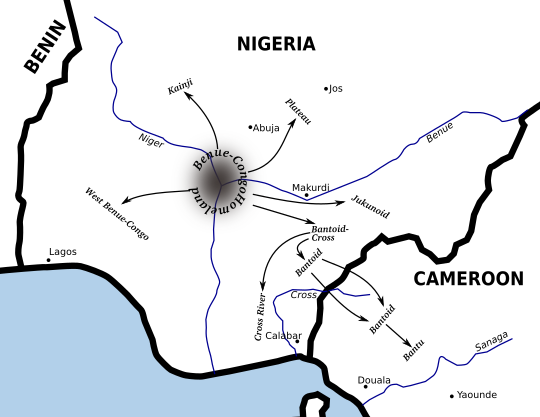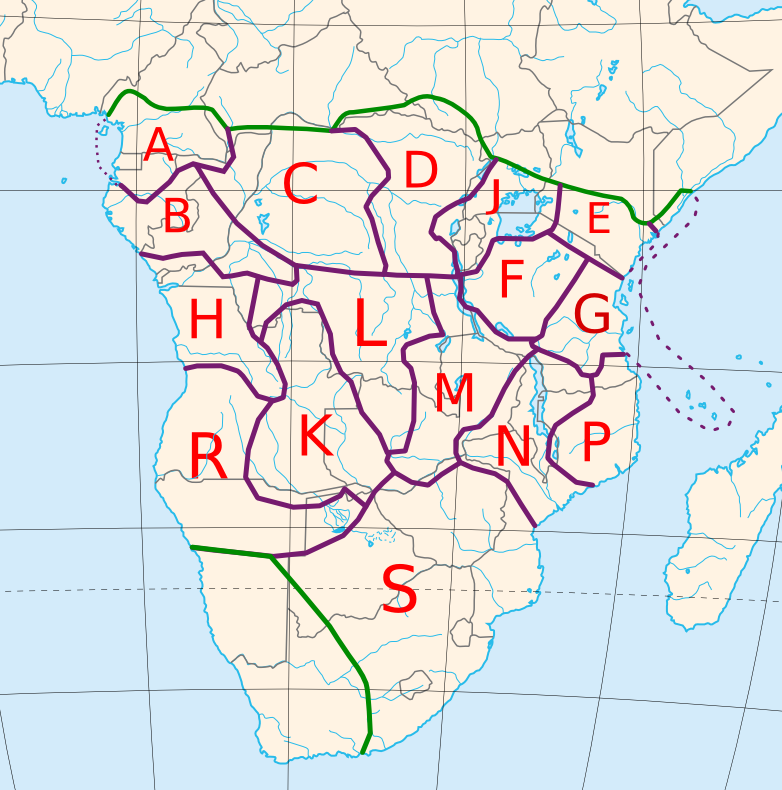|
Sabi Languages
The Sabi languages are a group of Bantu languages established by Christine Ahmed. They constitute much of Guthrie classification of Bantu languages#Zone M, Guthrie's Zone M. The languages, or clusters, along with their Guthrie identifications, are: *Taabwa language, Taabwa (Malungu, M40) *South Sabi: Bemba language, Bemba–Unga language, Unga (M40), Aushi language, Aushi, Lala-Bisa language, Lala-Bisa, Seba language, Seba, Swaka language, Swaka (M50) Bwile language, Bwile may belong here as well, as it is part of Guthrie's M40 group and Nurse (2003) does not note it as an exception, but it is not close to other languages and was not addressed by Ahmed. Similarly, although Spier (2020) focuses specifically on Aushi language, Aushi and includes an appendix comparing Sabi linguistic varieties, Bwile remains unaddressed due to limited available data. Nurse and Philippson suspect that the Botatwe languages may be related. Notes Further reading [...More Info...] [...Related Items...] OR: [Wikipedia] [Google] [Baidu] |
Zambia
Zambia, officially the Republic of Zambia, is a landlocked country at the crossroads of Central Africa, Central, Southern Africa, Southern and East Africa. It is typically referred to being in South-Central Africa or Southern Africa. It is bordered to the north by the Democratic Republic of the Congo, Tanzania to the north-east, Malawi to the east, Mozambique to the southeast, Zimbabwe and Botswana to the south, Namibia to the southwest, and Angola to the west. The capital city of Zambia is Lusaka, located in the south-central part of Zambia. The population is concentrated mainly around Lusaka in the south and the Copperbelt Province to the north, the core economic hubs of the country. Originally inhabited by Khoisan peoples, the region was affected by the Bantu expansion of the thirteenth century. Following European colonization of Africa, European colonisers in the 18th century, the British colonised the region into the British protectorates of Barotziland–North-Western Rho ... [...More Info...] [...Related Items...] OR: [Wikipedia] [Google] [Baidu] |
Democratic Republic Of The Congo
The Democratic Republic of the Congo (DRC), also known as the DR Congo, Congo-Kinshasa, or simply the Congo (the last ambiguously also referring to the neighbouring Republic of the Congo), is a country in Central Africa. By land area, it is the List of African countries by area, second-largest country in Africa and the List of countries and dependencies by area, 11th-largest in the world. With a population of around 112 million, the DR Congo is the most populous nominally List of countries and territories where French is an official language, Francophone country in the world. Belgian French, French is the official and most widely spoken language, though there are Languages of the Democratic Republic of the Congo, over 200 indigenous languages. The national capital and largest city is Kinshasa, which is also the economic center. The country is bordered by the Republic of the Congo, the Cabinda Province, Cabinda exclave of Angola, and the South Atlantic Ocean to the west; the Cen ... [...More Info...] [...Related Items...] OR: [Wikipedia] [Google] [Baidu] |
Atlantic–Congo Languages
The Atlantic–Congo languages make up the largest demonstrated family of languages in Africa. They have characteristic noun class systems and form the core of the Niger–Congo family hypothesis. They comprise all of Niger–Congo apart from Mande, Dogon, Ijoid, Siamou, Kru, the Katla and Rashad languages (previously classified as Kordofanian), and perhaps some or all of the Ubangian languages. Hans Gunther Mukanovsky's "Western Nigritic" corresponded roughly to modern Atlantic–Congo. In the infobox, the languages which appear to be the most divergent are placed at the top. The Atlantic branch is defined in the narrow sense (as Senegambian), while the former Atlantic branches Mel and the isolates Sua, Gola and Limba are split out as primary branches; they are mentioned next to each other because there is no published evidence to move them; Volta–Congo is intact apart from Senufo and Kru. ''Glottolog'', based primarily on Güldemann (2018), has a more limi ... [...More Info...] [...Related Items...] OR: [Wikipedia] [Google] [Baidu] |
Benue–Congo Languages
Benue–Congo (sometimes called East Benue–Congo) is a major branch of the Volta-Congo languages which covers most of Sub-Saharan Africa. Subdivisions Central Nigerian (or Platoid) contains the Plateau languages, Plateau, Jukunoid languages, Jukunoid and Kainji languages, Kainji families, and Bantoid–Cross combines the Bantoid languages, Bantoid and Cross River languages, Cross River groups. Bantoid is only a collective term for every subfamily of Bantoid–Cross except Cross River, and this is no longer seen as forming a valid branch, however one of the subfamilies, Southern Bantoid, is still considered valid. It is Southern Bantoid which contains the Bantu languages, which are spoken across most of Sub-Saharan Africa. This makes Benue–Congo one of the largest subdivisions of the Niger–Congo language family, both in number of languages, of which ''Ethnologue'' counts 976 (2017), and in speakers, numbering perhaps 350 million. Benue–Congo also includes a few minor Languag ... [...More Info...] [...Related Items...] OR: [Wikipedia] [Google] [Baidu] |
Southern Bantoid Languages
Southern Bantoid (or South Bantoid) is a branch of the Bantoid language family. It consists of the Bantu languages along with several small branches and isolates of eastern Nigeria and west-central Cameroon (though the affiliation of some branches is uncertain). Since the Bantu languages are spoken across most of Sub-Saharan Africa, Southern Bantoid comprises 643 languages as counted by ''Ethnologue'', though many of these are mutually intelligible. History Southern Bantoid was first introduced by Williamson in a proposal that divided Bantoid into North and South branches. The unity of the North Bantoid group was subsequently called into question, and Bantoid itself may be polyphyletic A polyphyletic group is an assemblage that includes organisms with mixed evolutionary origin but does not include their most recent common ancestor. The term is often applied to groups that share similar features known as Homoplasy, homoplasies ..., but the work did establish Southern Banto ... [...More Info...] [...Related Items...] OR: [Wikipedia] [Google] [Baidu] |
Bantu Languages
The Bantu languages (English: , Proto-Bantu language, Proto-Bantu: *bantʊ̀), or Ntu languages are a language family of about 600 languages of Central Africa, Central, Southern Africa, Southern, East Africa, Eastern and Southeast Africa, Southeast Africa. They form the largest branch of the Southern Bantoid languages. The total number of Bantu languages is estimated at between 440 and 680 distinct languages, depending on the definition of Dialect#Dialect or language, "language" versus "dialect"."Guthrie (1967–71) names some 440 Bantu 'varieties', Grimes (2000) has 501 (minus a few 'extinct' or 'almost extinct'), Bastin ''et al.'' (1999) have 542, Maho (this volume) has some 660, and Mann ''et al.'' (1987) have ''c.'' 680." Derek Nurse, 2006, "Bantu Languages", in the ''Encyclopedia of Language and Linguistics'', p. 2:Ethnologue report for Southern Bantoid" lists a total of 535 languages. The count includes 13 Mbam languages, which are not always included under "Narrow Bantu". ... [...More Info...] [...Related Items...] OR: [Wikipedia] [Google] [Baidu] |
Guthrie Classification Of Bantu Languages
The 250 or so "Narrow Bantu languages" are conventionally divided up into geographic zones first proposed by Malcolm Guthrie (1967–1971). These were assigned letters A–S and divided into decades (groups A10, A20, etc.); individual languages were assigned unit numbers (A11, A12, etc.), and dialects further subdivided (A11a, A11b, etc.). This coding system has become the standard for identifying Bantu languages; it was a practical way to distinguish many ambiguously named languages before the introduction of ISO 639-3 coding, and it continues to be widely used. Only Guthrie's Zone S is (sometimes) considered to be a genealogical group. Since Guthrie's time a Zone J (made of languages formerly classified in groups D and E) has been set up as another possible genealogical group bordering the Great Lakes. The list is first summarized, with links to articles on accepted groups of Bantu languages (bold decade headings). Following that is the complete 1948 list, as updated by Guthr ... [...More Info...] [...Related Items...] OR: [Wikipedia] [Google] [Baidu] |
Taabwa Language
Taabwa (Ichitaabwa; also called "Kitabwa" and spelled "Tabwa"), or Rungu (Malungu), is a Bantu language of Congo and Zambia Zambia, officially the Republic of Zambia, is a landlocked country at the crossroads of Central Africa, Central, Southern Africa, Southern and East Africa. It is typically referred to being in South-Central Africa or Southern Africa. It is bor ... spoken by half a million or so people. See also * Taabwa Twa References Further reading * Kalenga, Kaki A. 1992. ''Esquisse Grammaticale de la Langue Shila, Parler de Nkuba Bukongolo-Lac Moëro.'' Unpublished thesis, Université de Lubumbashi, DRCAvailable Here* Kavimbwa, Pierre Mutono. 2002. ''Elements de Phonologie et de Morphologie du Kitaabwa (M41a): Approche Structuraliste.'' Unpublished thesis, Université de Lubumbashi, DRCAvailable Here* Ntambo, Mwamba. 1984. ''Aspects Spatio-Temporels en Kitaabwa (M41).'' Unpublished thesis, Université de Lubumbashi, DRCAvailable Here* Rwakazina, Alphonse-Marie. ... [...More Info...] [...Related Items...] OR: [Wikipedia] [Google] [Baidu] |
Bemba Language
Bemba (natively known as ''Chibemba, Ichibemba'' and ''Chiwemba''), is a Bantu language spoken primarily in north-eastern Zambia by the Bemba people. History Bemba is spoken in rural and urban areas of the region, and is one of Zambia's seven recognized regional languages. Dialects Bemba has several dialects, which include Chishinga, Lomotwa, Ngoma, Nwesi, Lala, Luunda, Mukulu, and Ng’umbo. The Twa of Bangweulu speak another dialect of Bemba. Phonology and orthography The orthographical system in common use, originally introduced by Edward Steere, is quite phonetic. Its letters, with their approximate phonetic values, are given below. It has become increasingly common to use 'c' in place of 'ch'. In common with other Bantu languages, as affixes are added, combinations of vowels may contract and consonants may change. For example, 'aa' changes to a long 'a', 'ae' and 'ai' change to 'e', and 'ao' and 'au' change to 'o' (in other cases, a 'y' is often used to ... [...More Info...] [...Related Items...] OR: [Wikipedia] [Google] [Baidu] |
Aushi Language
Aushi, known by native speakers as ''Ikyaushi'', is a Bantu language primarily spoken in the Lwapula Province of Zambia and the (Haut-)Katanga Province of the Democratic Republic of Congo The Democratic Republic of the Congo (DRC), also known as the DR Congo, Congo-Kinshasa, or simply the Congo (the last ambiguously also referring to the neighbouring Republic of the Congo), is a country in Central Africa. By land area, it is t .... Although many scholars argue that it is a dialect of the closely related Bemba, native speakers insist that it is a distinct language. Nonetheless, speakers of both linguistic varieties enjoy extensive mutual intelligibility, particularly in the Lwapula Province. Phonology Aushi distinguishes consonants according to five manners and four places of articulation. Although nasal consonants are individually phonemic, prenasalized consonants also arise in conjunction with the voiced and voiceless counterparts of the plosives, affricates, and fri ... [...More Info...] [...Related Items...] OR: [Wikipedia] [Google] [Baidu] |
Lala-Bisa Language
Lala-Bisa is a Bantu language of Zambia Zambia, officially the Republic of Zambia, is a landlocked country at the crossroads of Central Africa, Central, Southern Africa, Southern and East Africa. It is typically referred to being in South-Central Africa or Southern Africa. It is bor ... that is closely related to Bemba. Swaka dialect is divergent, and sometimes classified as a separate language (Nurse 2003). Maho (2009) lists Biisa (Wisa), Lala, Ambo, Luano, and Swaka as distinct languages, with Ambo and Luano closest to Lala. References Languages of Zambia Languages of the Democratic Republic of the Congo Sabi languages {{Bantu-lang-stub ... [...More Info...] [...Related Items...] OR: [Wikipedia] [Google] [Baidu] |

